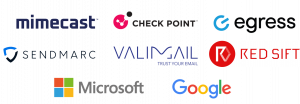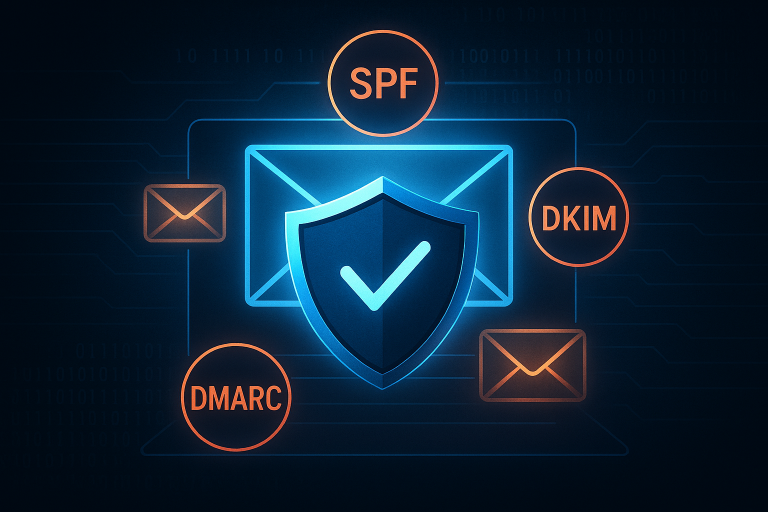Email remains the backbone of business communication, but it is also the most targeted channel for cybercriminals. From phishing to business email compromise (BEC), attackers exploit email because it is trusted and immediate. One of the most effective ways to prevent these threats is by implementing DMARC for email security. It is no longer an optional extra for organisations that want to secure their communications, protect their brand, and ensure their emails are delivered.
At ET Works, we help businesses adopt DMARC for email security to safeguard their communications and maintain trust with clients and partners.
What is DMARC for Email Security?
DMARC, which stands for Domain-based Message Authentication, Reporting and Conformance, is an email authentication protocol that builds on SPF (Sender Policy Framework) and DKIM (DomainKeys Identified Mail). These technologies work together to ensure that only authorised senders can send emails on behalf of your domain.
By implementing DMARC for email security, organisations can instruct recipient email servers on how to handle unauthorised or suspicious emails. This may include allowing the email through with caution, sending it to a spam folder, or rejecting it outright.
Why DMARC Matters
Without DMARC, anyone can impersonate your organisation’s email domain. Cybercriminals exploit this to send fake invoices, trick staff into transferring funds, or launch phishing attacks against your customers and suppliers.
The risks include:
- Financial loss. Fraudulent payment requests sent to customers or finance teams can lead to large sums being stolen.
- Reputational damage. If clients receive scam emails appearing to come from your organisation, they may lose trust in your brand.
- Data compromise. Spoofed emails are often used to harvest logins, passwords, or confidential data.
- Poor deliverability. Legitimate emails risk being marked as spam if providers cannot verify their authenticity.
By implementing DMARC for Email Security, organisations gain:
- Brand protection. Only genuine emails are allowed to use your domain.
- Stronger defences. Spoofing, phishing, and impersonation attacks are blocked at the gateway.
- Improved deliverability. Verified emails are more likely to land in the inbox rather than the spam folder.
- Visibility and control. DMARC reports give detailed insight into who is sending emails on behalf of your organisation.
- Regulatory alignment. Many industries now expect or mandate email authentication as part of compliance frameworks.
Microsoft and Google: Raising the Bar on Email Security
The global technology giants are now enforcing stricter email authentication requirements, which makes DMARC adoption more urgent.
- Google and Yahoo: Since February 2024, both providers require bulk senders (organisations sending over 5,000 messages per day) to have SPF, DKIM, and DMARC in place. If not, emails may be rejected outright or sent to spam. For marketing, customer engagement, and critical communications, this has major implications.
- Microsoft: Office 365 and Outlook use DMARC as part of their Advanced Threat Protection layers. Microsoft strongly recommends enforcement policies (quarantine or reject) and has adopted BIMI (Brand Indicators for Message Identification) for organisations with a strong DMARC policy. This allows verified brands to display their logo directly in the inbox, reinforcing trust with every message.
The message from the largest mailbox providers is clear. Without DMARC, your emails may not be delivered, and your brand remains vulnerable to impersonation.
How DMARC Works
Implementing DMARC is a journey rather than a single step. The process usually follows four phases:
- Publish a DMARC record
A DMARC record is placed in your domain’s DNS. Initially, this is set to monitoring mode (policy = none). This allows you to collect data without blocking emails. - Monitor and analyse reports
DMARC generates feedback reports that show which servers and services are sending emails on behalf of your domain. This helps you identify authorised services (such as marketing platforms or CRM systems) and spot unauthorised activity. - Tighten policies
Once you are confident that legitimate services are aligned, you can increase protection by moving your policy to quarantine. Suspicious emails are delivered to spam folders rather than inboxes. - Enforce rejection
The final stage is a reject policy, which blocks unauthorised emails completely. This is the strongest defence against spoofing and phishing attacks. - Maintain and adjust
DMARC is not a one-off project. As new services are added (for example, a new payroll provider or marketing tool), your DMARC record must be updated.
Regular monitoring is crucial to ensure DMARC for email security remains effective as your organisation evolves.
Why Now?
There are three main reasons why businesses need to act on DMARC today:
- Escalating cyber threats. Phishing remains the most common attack vector. Criminals will continue to target email because it works.
- Provider requirements. Google, Yahoo, and Microsoft are tightening their controls. Without DMARC, your organisation risks deliverability issues and reputational harm.
- Customer trust. Clients increasingly expect the businesses they deal with to safeguard communications. DMARC demonstrates that you take security and trust seriously.
How ET Works Can Help
Implementing DMARC can feel complex, particularly for organisations managing multiple domains, third-party services, and cloud email platforms. At ET Works, we simplify the process by:
- Assessing your current email infrastructure.
- Publishing and tuning your DMARC record.
- Monitoring reports to identify authorised and unauthorised senders.
- Guiding you step by step from monitoring to enforcement.
- Providing ongoing management and support to keep your protection effective.
We work closely with leading DMARC technology partners to ensure your business benefits from proven solutions that are reliable, scalable, and easy to manage.
Conclusion
Email continues to be the lifeblood of business communication, but it is also the most common route for cyberattacks. With Microsoft, Google, and Yahoo tightening the rules, DMARC is now essential for any organisation that wants to protect its reputation and ensure its emails are delivered.
By deploying DMARC, you can prevent fraud, build trust, and strengthen your cyber resilience. ET Works is here to guide you through every step of that journey, helping you make email communication secure, trusted, and delivered.
References
- UK NCSC guidance on email security
- Google Gmail authentication requirements
- Microsoft Office 365 DMARC guidance
- Mimecast: Google & Yahoo! DMARC Requirements – 2024 Update
Tools





